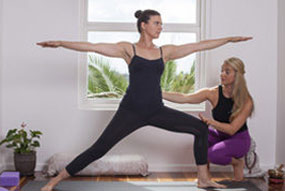

In Sanskrit, the word yoga means ‘to yoke’, the joining of one thing to another. In the West, the term is generally used in reference to Hatha Yoga, the physical practices set forth by Patanjali.
Yoga has become a trend and an industry so much so that you’ll find a yoga school offering various styles in every town or city – some concerned with yoga’s effectiveness as a physical exercise, others offering a more holistic approach.
It’s no surprise students and teachers alike can get confused about the different yoga styles available to them.
Hatha yoga describes the physical practice of yoga poses, using postures in alignment with the breath. It encompasses every kind of yoga asana practice – from Iyengar to Ashtanga. The actual word ‘Hatha’ can be translated as ‘wilful’, the yoga of activity, and as ‘sun’ (ha) and ‘moon’ (tha), the yoga of balance. Hatha practices are designed to align and calm your body, mind and spirit in preparation for meditation.
Finding a yoga style that is right for you depends on your needs and capabilities – we recommend discussing this with your teacher or local yoga studio. Feel free to contact us here if you’d like to have a chat.
Most agree that the origins of Hatha yoga can be found in Patanjali Maharishi’s yoga sutras, 196 sutras (aphorisms) written in Sanskrit around 400 AD.
In his work, Patanjali describes Hatha yoga as consisting of eight limbs, or disciplines, and referred to it as the eightfold path. If you would like to learn more about yoga philosophy, head here to read about the eight limbs.
Depending on the needs and experience levels of the students in the class, you may expect to be offered a gentle, moderate or strong class involving familiar yoga postures (asanas) to develop strength in your body and quietness and relaxation in your mind. The poses build upon one another, thus guiding you through a yoga pose sequence (usually without flow), and addressing or working with a specific health benefit or theme.
Most teachers will offer breathing techniques (pranayama) and introduce you to some form of meditation at the beginning or end of the class.
Yoga is your opportunity to ‘meet yourself’ and Hatha classes are a wonderful way to:
Head here to read about other benefits that your yoga practice has to offer.
Just to add to the confusion, you may have seen Hatha Flow or Dynamic Hatha in the timetable of your favourite studio. You can expect these classes to be a little more vigorous, moving from pose to pose in a carefully designed yoga pose sequence (similar to Vinyasa yoga). The style and level of the class will depend on each individual teacher and the needs and abilities of the other students in the class.
Hang on, didn’t we just say Hatha yoga usually doesn’t involve a flow?
That’s right. However, just as we encourage relaxation and a calmer practice when your body needs it (e.g. in the evening after a long day at work), you may find you benefit from a stronger, energising practice at certain times of the day.
Simply try a Hatha class to find out whether this yoga style appeals to you and seems right for your body. Hatha classes provide an opportunity to stretch, unwind and release tension, helping you balance a busy lifestyle – or bring more energy into your body and mind.
Above all else, listen to your body. We recommend discussing what it is you want to achieve with your teacher or local studio to find the right style of yoga for you.
 Another Post that�s poular
Another Post that�s poular Another Post that�s poular
Another Post that�s poular Another Post that�s poular
Another Post that�s poular Another Post that�s poular
Another Post that�s poular Another Post that�s poular
Another Post that�s poular Another Post that�s poular
Another Post that�s poular Another Post that�s poular
Another Post that�s poular Another Post that�s poular
Another Post that�s poular